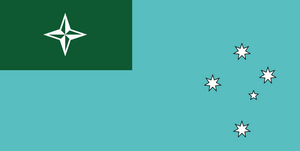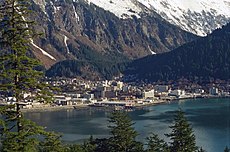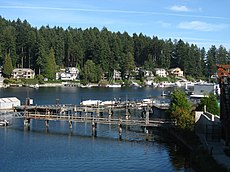Saxalin Islands
| Colony of Sakhalin Axerka Saxalin (Kiravic) | |
 Flag | |
| Country | |
| Theme | |
| Capital | Kærasta |
| Population | 3,275,000 |
| Governor | A. Kyrin Væhitin |
| Chancellor | D. Lenihan Śirayakin (INP) |
| Stanora seats | 3 |
| Official languages | Chadian Kiravic |
| Other Languages | Austral Coscivian Australic Coscivian |
| Postal Abbreviation | SAX |
The Colony of Saxalin is a Kiravian colony located on an archipelago of three large islands in the Absurian Ocean. The main islands are, from largest to smallest in land area, Éorlin, Kallak, and Perryn.
Geography
The Saxalin Islands have a diverse landscape harbouring numerous niche microclimates and unique ecosystems. Due to the isolation of the archipelago, much of its flora and fauna are endemic.
Wildlife
History
The Saxalin Islands have no native population, remaining unpeopled for millennia due to their remoteness and the harsh conditions of the surrounding ocean.
The islands were officially discovered by the Kiravian navigator Magloir Korentin of Ilánova, one day before the vernal equinox of 1772 AD. Korentin authorised a landing party to make landfall on what would turn out to be the largest of the three main islands and claim it for the Marble Emperor.
They were first settled in 1801 AD by Coscivians from Kiravia and Sydona. These early Coscivian colonists were mostly landless agricultural workers recruited by the General Emigration Board to establish a permanent Kiravian presence on the islands and substantiate the Kiravian claim thereto. They made their living primarily by fishing, farming, and keeping sheep and goats. Growth of these early free settlements was limited by the irregular schedule of resupply vessels from Sydona, harsh weather conditions, and a few dropouts. Kiravian occupation of the islands would truly take off with the introduction of penal colonists and parolee settlers.
Later, serious mineral prospecting and the promise of mineral wealth attracted more emigrants to the remote archipelago.
Sunderance Era
For the duration of Kirosocialist rule on the Kiravian mainland, the Saxalins would remain under the control of the Æonara-based Federalist government. The Kiravian Union had designs on capturing the archipelago by means of a naval assault from Sydona, but these plans never came to fruition, as the government had other priorities, but the threat of invasion was credible enough to force the Federalists to divert a substantial share of resources to provide for the islands' defence. Occasional interdiction of seaborne trade to and from the islands occurred until the stabilisation of relations between the Federalist and Kirosocialist governments in 211YY.
The Sunderance was a difficult time for the Sakhalin colonists. Although the Federalist government subsidised the colony and its population as heavily as it could reasonably afford to, its resources were limited. Many Sakhalinites emigrated during this time: Some sought better fortunes in the economic hubs of Sarolasta and Æonara, while others, especially those with backgrounds in the local mining and timbering trades, crossed to the other side of the world for new opportunities in Porfíria and Thýstara.
Post-Restoration
Politics & Governance
| Party | Seats | Caucus | Platform | |
|---|---|---|---|---|
| Renaissance Party Plaiduv Inoguamsk |
55 / 90 |
SRA | Conservatism, Shaftonist democracy | |
| Social Democrats KF Soksyalthāruārkarisēnya KR |
25 / 90 |
ISD | Social democracy, Miners' interests | |
| Imperial Federation Party Plaiduv Vādrivuntiārká |
5 / 90 |
AHC | Imperial federalism, Traditionalist conservatism | |
| Social Credit Party Plaiduv Askolamistresk |
5 / 90 |
n-i | Social credit | |
| Nonpartisans Dhiplaidulix |
5 / 90 |
-- | -- |
Society & Culture
Denizens of the Saxalin Islands are known as Saxalites in Ænglish.
The ethnic makeup of the Sakhalins is 91% Coscivian, 6% Celtic, and 3% other (including Pelians, Skithanawites, Érhuans, Thrakoslavs, and Daxians).
The largest individual Coscivian subgroups in the Sakhalins are Austral Coscivians from Sydona, Australic Coscivians from Koré'hetanùa, Kandan Coscivians, Eshavian Coscivians, Arnórian and Norborian Coscivians, West Coast Marine Coscivians, Kaltan and Phrydhian Coscivians, and Æonaran Coscivians. Vibrant communities of Sēoran Coscivians (Kāloatem, Vespâniem, Koralem, Ibuskem), Tenebric Coscivians (Iruktem, Kibirskem, Krôysanyem), and Caspoärian Coscivians (Stelanovians, Cervonians), Pineratem, and Túkluskans have settled in previously undeveloped rural areas in the interior of the islands, and in the mining communities.
Economy

The economy of the Saxalin Islands is built atop a strong primary sector. The two most important components of the primary sector are offshore oil and gas extraction and nickel mining on [island]. Several other minor mineral deposits are also currently being mined.
A major impediment to the colony's economic further development is its remoteness. Distance from foreign markets acts as a damper on industrial development and export-oriented growth, and high transport costs are passed on to Saxalinite consumers, resulting in a high cost of living. Since the Restoration and the Kiravian economic recovery, prospects have improved thanks to advances in transportation and telecommunications, the reöpening of the mainland Kiravian market to Saxalin commodities, a larger federal aid budget, and the growth of the service sector.
The pristine natural environment of the Saxalin Islands, including rugged wilderness, national parks, and stunning coastlines, has made it a popular destination for tourists. Tourism is a key driver of the economy, with visitors attracted to outdoor activities, cultural experiences, and the world-famous Saxalinic wilderness. Sakhalin is a major stopping-off point for Antarctic cruises.
Agriculture & Forestry
The most profitable agricultural venture in the Sakhalins is the raising of sheep for wool. Hogs, goats, and a small number of Highland Ginger cows are also reared to produce premium quality meat and dairy products. Crop farming on the islands is limited mostly to staple foods such as potato, cale, barley, and rye, as well as feed crops for livestock, however, these is a significant fruit sector producing cherries, various berries, and apples. The Saxalins are a leader in aquaculture, with a strong focus on salmon farming. The colony's clean and cold waters provide an ideal environment for high-quality seafood production, and salmon is a valuable export product.
Historically, forestry was a major industry in the Saxalins, mainly oriented toward the local construction industry and exports to Sydona. While it has faced challenges due to environmental concerns, sustainable forest management practices have helped maintain this industry, which produces timber, pulp, and paper products.
Offshore energy
Oil and gas
The seabed of waters off the Saxalins are home to some of the largest oil and gas reserves in the Kiravian Collectivity, and the largest outside of Sydona. Active oil and gas exploration and extraction have been underway since the 1960s, and contemporary production is concentrated in three main offshore fields.
Renewable energy
The stormy circumpolar waters surrounding the Saxalins have been identified as a potentially lucrative source of renewable energy. The first attempt at harnassing the violent sea winds was made in 2004, when the Contiguous Zone Authority issued a licence to Xéulev-based ElectricSlide SAK to erect an offshore wind farm on the semi-submerged Reseda Shoals. The project was abandoned in October 2006 after a storm destroyed most of the construction infrastructure and killed eleven workers, leaving the company bankrupted by sunk costs.[1] Salvage operations, for which ElectricSlide was was liable under the aforementioned development licence, were covered by the project's insurer, Berengar Marine of Kérvoak, and carried out by a Burgundine contractor, Remarque & Emmenoit Marine Salvage Services.
Gallery
 |
 |
 | |
 |
 |
 | |
 |
 |
 |
 |
Notes
- ↑ Pun intended
